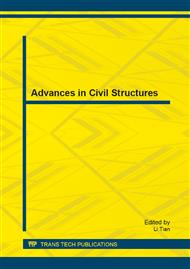p.26
p.30
p.34
p.38
p.42
p.46
p.50
p.55
p.61
An Engineering Mechanics Based Approach to Predict Safety of RC Columns under High Temperatures
Abstract:
Up till now, the design code for the determination of fire resistance of reinforced concrete (RC) columns is essentially based on tabulated data. Clearly, a more scientific approach based on an understanding of the fundamental behavior of columns in fire is timely andwill be useful to structural engineers. This paper develops a straightforward and rational method to predict the fire resistance of RC columns,which is based on the traditional Rankine approach. The effect of shear bond, if included in the Rankine approach, will yield moreaccurate predictions. Material deterioration at elevated temperature with regard to the strength and stability of columns is also quantified.
Info:
Periodical:
Pages:
42-45
Citation:
Online since:
August 2013
Authors:
Keywords:
Price:
Сopyright:
© 2013 Trans Tech Publications Ltd. All Rights Reserved
Share:
Citation:


